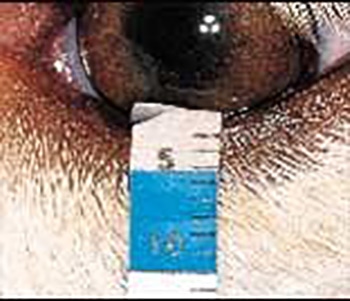MSD, the manufacturer of Optimmune®, is encouraging dog owners to become more aware of the condition known as 'dry eye' or Keratoconjunctivitis sicca.
Dry Eye is a very common ocular condition in dogs. One in 22 dogs are affected and in some breeds it is almost double this. Cocker Spaniels, Cavalier King Charles Spaniels, West Highland White Terriers and Shih Tzus are prone to the condition.
An adequate supply of tears is essential in eye function. A film of tears covers the surface of the eyes. This protects the surface of the eye, removes foreign material and debris from the eye’s surface, helps with passage of oxygen and nutrients into the eye and possesses antibacterial properties. In most cases Dry Eye is caused by the immune system destroying the tear producing cells in the lacrimal gland.
Symptoms
Dry Eye can vary in severity. It can progress slowly and early cases may show only an intermittent conjunctivitis. It can also be so severe that vision is lost. Usually both eyes are affected although one may be worse than the other.
When tear production is low eyes will become itchy, feeling like the have grit in them, and a thick discharge will be produced. The lack of protective tears means the eye will be prone to infection or ulceration. Scarring and pigment in the surface of the eye will cause blindness, which can be permanent.
Common signs:
Uncomfortable, itchy eyes
Sticky or crusty discharge
Red, inflamed eyes
Frequent conjunctivitis, eye infections or corneal ulcers
Changes to the surface of the eye (cornea) e.g prominent blood vessels, patches of dark pigment
Diagnosis

A Schirmer Tear Test will be performed if your vet suspects Dry Eye. This involves placing a special paper strip under the lower eyelid for approximately 60 seconds. This test is painless and gives an immediate result. Wetting of the strip by tears moves a dye along the strip which changes colour. The amount of the strip which is wetted within 60 seconds is recorded. In normal dogs the dye will move 15-25mm in a minute.
Treatment
A patient with Dry Eye usually requires life-long treatment. Regular check-ups will be an important part of monitoring your dog’s condition and their response to treatment.
Optimmune (Ciclosporine) is an eye ointment used to treat Dry Eye. It targets the altered immune response controlling painful inflammation and increasing natural tear production. This is the only treatment which addresses the underlying cause of the disease. A small droplet, about the size of a grain of rice is applied. Twice daily treatment will usually be advised. An increase in tear production should be seen within 2 weeks although it can take up to 6 weeks to reach maximum benefit.
Other treatments: Various tear replacement products are available to help lubricate and protect the eye. Unfortunately these need to be reapplied very frequently to keep the eye adequately moist (As often as every 30 minutes in some cases). For this reason artificial tear products alone are not practical to control Dry Eye. They are often used in the early stages. Sometimes lifelong tear replacement is needed in addition to Optimmune although in many cases this treatment can be stopped once natural tear production has improved.
Concurrent eye infections may be treated with antibiotic drops. Sometimes anti-inflammatory treatments will also be used until symptoms have improved.
A surgical treatment is available for Dry Eye but the procedure is not without complications and is usually only advised for cases which have failed to respond to medical treatment. Your pet would be referred to an ophthalmologist for this procedure.
Please contact us to book an appointment.




